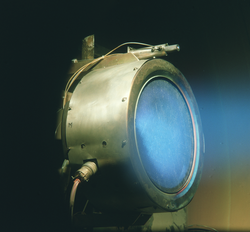Ion thruster
An ion thruster is a type of spacecraft thruster. It works by using static electricity or magnetism to push ions (atoms that have an electric charge) out of the back of the spacecraft.[1] It takes a very long time for the spacecraft to speed up, but the fuel is used very efficiently. A thruster that has very high efficiency is said to have a high specific impulse.
It has to be carried into outer space by a regular rocket, because the ions don't push hard enough for it to escape the Earth's atmosphere, but after it gets to outer space it can travel a very long way. An ion thruster needs lots of electricity to work, so the spacecraft needs a very good way of producing electricity, such as solar panels or a nuclear reactor.[1]
Ion thrusters are good for travelling between things in space that are very far away from each other. One example of this is interplanetary travel. Ion thrusters are good for this because they are efficient and can thrust for very long times.[1] Chemical rocket thrusters ("regular" rocket thrusters) can only burn for short times, because they use fuel quickly and not efficiently. Because of this, chemical rockets only thrust for short times at important places during the journey. Ion thrusters use fuel very slowly and very efficiently. This means that ion thrusters can thrust continuously for the entire journey. In a slightly surprising way, this makes spacecraft that use ion thrusters faster than spacecraft that use chemical rockets.[1]
Ion thrusters have been used on small space probes. In 2011 the NASA space probe called Dawn used an ion thruster to get to the asteroid named Vesta.[2] In 2015 the thruster brought Dawn to the dwarf planet named Ceres.[3]
Ion Thruster Media
The 2.3 kW NSTAR ion thruster developed by NASA for the Deep Space 1 spacecraft during a hot fire test at the Jet Propulsion Laboratory (1999)
Raymond J. Rulis, SERT-1 Program Manager, is shown here examining the SERT-1 spacecraft after its arrival at the NASA Lewis Research Center for pre-flight testing. The Lewis built ion engine is in front of Mr. Rulis, and the Hughes engine, in its vacuum pod, is on the other side. Lewis is now known as the John H. Glenn Research Center.
References
- ↑ 1.0 1.1 1.2 1.3 DeFelice, David. "NASA - Ion Propulsion: Farther, Faster, Cheaper". www.nasa.gov. Archived from the original on 2020-11-11. Retrieved 2022-11-03.
- ↑ "NASA's Dawn Spacecraft Enters Orbit Around Asteroid Vesta". NASA Jet Propulsion Laboratory (JPL). Retrieved 2022-11-03.
- ↑ "NASA Jet Propulsion Laboratory Blog | We Did It! Dawn Arrives at Dwarf Planet Ceres". www.jpl.nasa.gov. Retrieved 2022-11-03.
| Wikimedia Commons has media related to Lua error in Module:Commons_link at line 62: attempt to index field 'wikibase' (a nil value).. |







